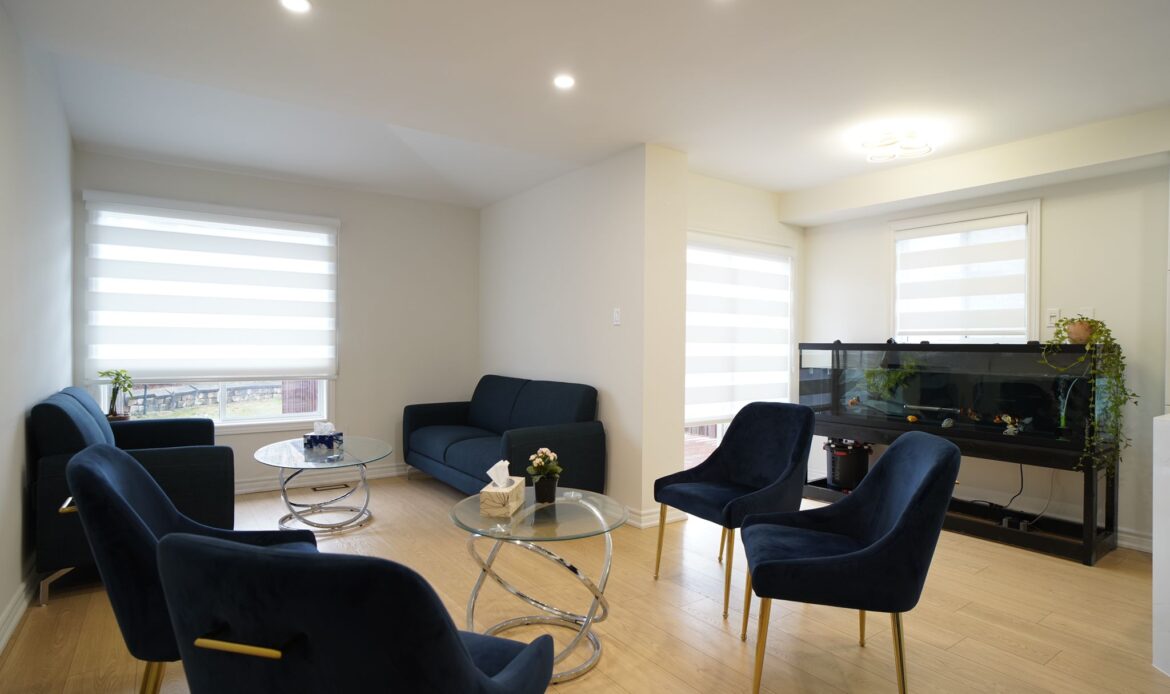Open-concept homes have become a popular trend in Toronto, promising a spacious, modern, and connected living experience. Many homeowners in the GTA are drawn to this design because it removes walls between common areas, allowing light to flow freely and making spaces feel larger. But is an open-concept layout always the right choice for your home?
In this guide, we’ll explore the pros and cons of open-concept homes in Toronto. By understanding both the benefits and potential drawbacks, you can make an informed decision that fits your lifestyle, family needs, and renovation goals. Whether you’re planning a full home remodel or a simple upgrade, knowing what to expect will help you create a space that’s both functional and stylish.
Table of Contents
Pros of Open-Concept Homes in Toronto
Open-concept homes have surged in popularity across Toronto and the GTA, and for good reason. Removing walls and creating larger shared spaces can transform a home, offering both aesthetic appeal and practical advantages. Understanding the key benefits will help homeowners decide if this design suits their lifestyle and renovation goals.
1. Enhanced Natural Light and Spaciousness
One of the most significant advantages of open-concept layouts is the increased flow of natural light. By eliminating walls between the kitchen, dining, and living areas, sunlight can travel freely throughout the home. This creates a brighter, more inviting environment, which not only improves mood but can also make rooms feel larger.
Steps to maximize light in an open-concept space:
- Position large windows strategically to capture sunlight.
- Use light-colored walls and ceilings to reflect natural light.
- Incorporate skylights or glass doors where possible.
2. Improved Social Interaction
Open-concept homes foster better communication and connection among family members and guests. Parents can prepare meals in the kitchen while keeping an eye on children in the living area. Similarly, social gatherings feel more inclusive when everyone shares the same open space rather than being separated by walls.
Steps to enhance social interaction:
- Arrange seating areas that encourage conversation.
- Design a multifunctional island or breakfast bar to serve as a gathering point.
- Use furniture to subtly define zones without creating barriers.
3. Flexible Space for Modern Living
With fewer walls, open-concept homes provide flexibility for furniture placement and room functionality. Families can adapt spaces as their needs change, whether it’s creating a play area for kids, a home office corner, or an entertainment space. This versatility is particularly valuable for Toronto homeowners who may renovate to accommodate evolving lifestyles.

Steps to create flexible spaces:
- Use modular furniture that can be easily moved or reconfigured.
- Add area rugs or lighting to delineate different zones.
- Plan for storage solutions that blend seamlessly into the open layout.
4. Enhanced Resale Value
Homes with open layouts are highly sought after in Toronto’s competitive real estate market. Buyers often prioritize bright, spacious, and modern interiors. By choosing an open-concept design during renovations, homeowners can increase their property’s appeal and potential resale value.
Steps to boost resale value:
- Keep the design neutral to appeal to a wide audience.
- Focus on high-quality finishes and cohesive design elements.
- Ensure the layout allows for easy traffic flow and functional living areas.
5. Modern Aesthetic and Trend Alignment
Open-concept homes offer a sleek, contemporary look that aligns with current architectural and interior design trends. Exposed beams, minimalist cabinetry, and seamless flooring create a cohesive and stylish environment that resonates with modern homeowners.
Steps to enhance aesthetic appeal:
- Choose consistent flooring materials across open spaces.
- Incorporate a cohesive color palette and matching furniture styles.
- Use statement lighting fixtures to define different functional areas.
6. Easier Entertaining and Hosting
For homeowners who love to entertain, open-concept layouts make hosting events more convenient and enjoyable. Guests can move freely between the kitchen, dining, and living areas without feeling confined, while hosts can engage with everyone without leaving the preparation space.
Steps to optimize for entertaining:
- Include a large island or peninsula for serving food.
- Arrange seating to encourage mingling and conversation.
- Ensure ample lighting and ventilation to accommodate larger gatherings.
Cons of Open-Concept Homes in Toronto
While open-concept homes have many advantages, they are not without drawbacks. Understanding the potential downsides is crucial for Toronto homeowners considering this popular design trend. Being aware of these challenges helps in planning renovations that maximize benefits while minimizing issues.
1. Noise and Lack of Privacy
One of the biggest challenges in open-concept homes is the lack of sound separation. Without walls, noise from the kitchen, television, or conversations can easily travel across the space. This may be disruptive for families working or studying from home or for those who value private spaces.
Steps to mitigate noise issues:
- Use area rugs, curtains, or acoustic panels to absorb sound.
- Incorporate strategically placed bookshelves or screens to create quiet zones.
- Choose quieter appliances to reduce kitchen noise.
2. Heating and Cooling Challenges
Open-concept layouts can make temperature regulation more difficult. Large, interconnected spaces may require more energy to heat or cool evenly, potentially increasing utility bills. Toronto homeowners should be aware of these costs when planning a major renovation.
Steps to improve energy efficiency:
- Invest in energy-efficient HVAC systems or ductless mini-splits.
- Use ceiling fans to improve air circulation.
- Add insulation and double-glazed windows to reduce heat loss or gain.
3. Limited Wall Space
Removing walls reduces available surface area for furniture, artwork, and storage solutions. Homeowners who rely on walls for shelving, cabinets, or decorative pieces may find open-concept spaces challenging to furnish effectively.
Steps to maximize wall functionality:
- Use multifunctional furniture, like storage benches or room dividers.
- Add floating shelves and tall cabinets where walls remain.
- Consider built-in storage solutions that blend with the open design.
4. Cooking Smells and Kitchen Visibility
In an open-concept home, kitchen odors can easily spread to living and dining areas. Additionally, the kitchen remains visible at all times, requiring homeowners to maintain a consistently clean and organized space. This can be stressful for some families.

Steps to control odors and maintain cleanliness:
- Install a high-quality range hood with proper ventilation.
- Use air purifiers and natural odor absorbers, like activated charcoal.
- Maintain a clutter-free kitchen with organized storage solutions.
5. Cost Considerations
Transforming a traditional home into an open-concept layout can involve significant costs. Removing load-bearing walls, rerouting electrical and plumbing systems, and reinforcing structures may increase renovation expenses. Toronto homeowners should budget carefully to avoid surprises.
Steps to manage costs:
- Consult with a licensed contractor or structural engineer before removing walls.
- Compare multiple quotes to ensure fair pricing.
- Plan renovations in phases if needed to manage cash flow.
6. Potential for Clutter
Open-concept spaces can appear cluttered quickly, as there are fewer enclosed areas to hide belongings. Without careful organization, the home may lose the sleek, spacious appeal that open layouts are designed to provide.
Steps to prevent clutter:
- Incorporate hidden storage solutions, such as ottomans and under-seat drawers.
- Use decorative baskets and boxes to keep items organized.
- Establish daily habits for tidying and maintaining open spaces.
Considerations Before Opting for an Open-Concept Renovation in Toronto
Open-concept home renovations have become a popular trend in Toronto, offering spacious interiors and a modern aesthetic. However, before committing to removing walls or redesigning your home, it’s important to carefully evaluate several factors. Making informed decisions ensures that your renovation delivers the desired functionality, style, and long-term value.
1. Evaluate Your Family’s Lifestyle Needs
Before starting an open-concept renovation, consider how your household uses its space. Families with young children may need separate areas for play, study, or work, while those who entertain frequently may prefer large communal spaces.
Steps to assess lifestyle needs:
- Make a list of daily activities and how your family uses each room.
- Identify areas where privacy or separation is essential.
- Discuss priorities with your family to ensure the renovation suits everyone’s needs.
2. Understand Structural Limitations
Not all walls can be removed without affecting your home’s structural integrity. Load-bearing walls, plumbing, and electrical systems may require special attention when planning an open-concept layout.
Steps to check structural feasibility:
- Hire a licensed contractor or structural engineer to assess your home.
- Determine which walls are safe to remove and which require reinforcement.
- Factor in additional costs for structural modifications or permits.
3. Budget Considerations
Open-concept renovations often involve more than just knocking down walls. Hidden costs such as rerouting electrical or plumbing systems, reinforcing structures, or upgrading HVAC can increase the overall budget.
Steps to plan your budget effectively:
- Obtain detailed quotes from multiple contractors.
- Include a contingency fund for unexpected expenses.
- Consider phasing the renovation to manage costs while achieving your vision.
4. Lighting and Ventilation Needs
Open spaces may require different lighting and ventilation strategies. Without walls to divide spaces, natural and artificial light must be strategically planned to maintain comfort and functionality.
Steps to optimize lighting and airflow:
- Use layered lighting, including ambient, task, and accent lights.
- Maximize natural light through windows, skylights, and glass doors.
- Ensure proper ventilation with ceiling fans, range hoods, and air circulation systems.
5. Storage Solutions
With fewer walls, storage options in open-concept homes can be limited. Thoughtful planning is needed to maintain organization and avoid clutter in a wide, open space.
Steps to enhance storage:
- Integrate built-in storage units, shelves, and cabinetry.
- Use multifunctional furniture, such as storage benches or islands with drawers.
- Designate zones for everyday items to keep spaces neat and accessible.
6. Acoustics and Privacy
Sound travels more easily in open-concept layouts, which can be challenging for families who work, study, or relax at home simultaneously. Privacy is also limited without enclosed rooms.
Steps to improve acoustics and privacy:
- Install sound-absorbing materials like rugs, curtains, and acoustic panels.
- Use partial walls, furniture, or sliding partitions to create subtle separations.
- Designate quiet areas for work or study to maintain productivity.
7. Resale Value Considerations
While open-concept homes are trendy, not all buyers prefer them. It’s important to consider the potential impact on your home’s resale value in the Toronto real estate market.
Steps to balance trends and resale:
- Consult with a real estate professional about current market preferences.
- Ensure the renovation allows flexibility, such as adding removable partitions.
- Focus on timeless, high-quality finishes that appeal to a wide audience.
Conclusion
Open-concept home renovations in Toronto can transform a house into a bright, spacious, and modern living space. However, it’s essential to carefully evaluate your lifestyle needs, structural limitations, and budget before committing. Considering factors like lighting, storage, acoustics, and resale value ensures your renovation delivers both functionality and style. By planning thoughtfully and working with experienced Toronto renovation professionals like Ahoora Homes, homeowners can avoid common pitfalls and create a comfortable, open-concept home that truly enhances daily living. A well-executed open-concept renovation not only elevates your home’s aesthetic but also increases its long-term value and appeal.
FAQs
-
What is an open-concept home renovation?
An open-concept home renovation involves removing walls or barriers to create large, interconnected living spaces. This design improves natural light, enhances social interaction, and provides a modern, spacious feel throughout the home.
-
Are open-concept renovations suitable for families with children?
Yes, but careful planning is needed. While open spaces encourage togetherness, parents may need designated zones for study, play, or work to maintain organization and privacy. Sound management solutions can also improve comfort.
-
How much does an open-concept renovation in Toronto typically cost?
Costs vary depending on the size of your home, structural changes, and upgrades required. Homeowners should budget for demolition, structural support, electrical or plumbing modifications, lighting, and storage solutions to get accurate estimates.
-
What are the main challenges of open-concept homes?
Open-concept homes can face issues with noise, limited privacy, and storage constraints. Proper planning, soundproofing, multifunctional furniture, and strategic layout design can help overcome these challenges while maintaining the open, airy feel.
-
Can open-concept renovations increase my home’s resale value?
Yes, if done thoughtfully. Open-concept spaces are attractive to many buyers, but it’s important to balance modern design with practical needs. Flexible layouts, high-quality finishes, and professional execution can enhance both appeal and market value.

